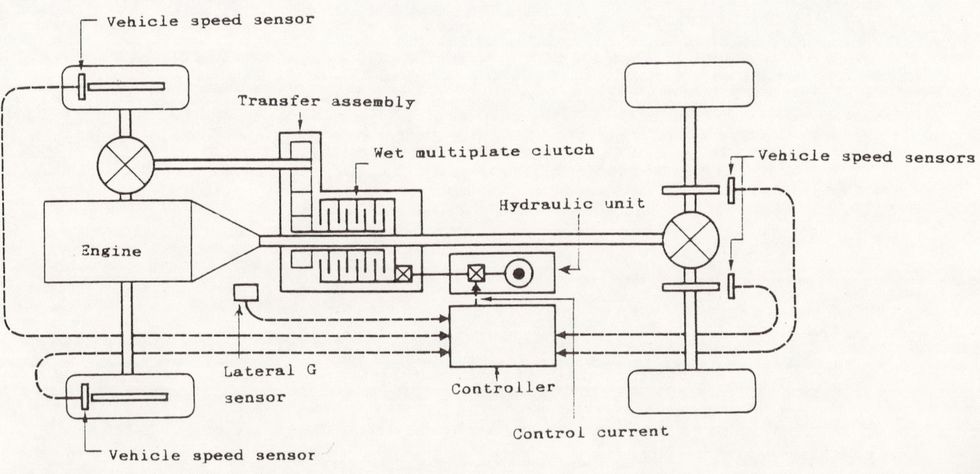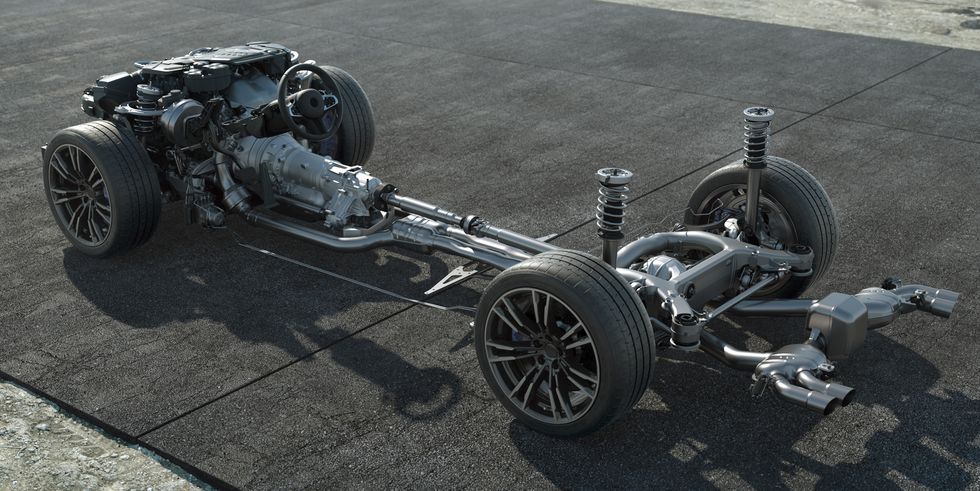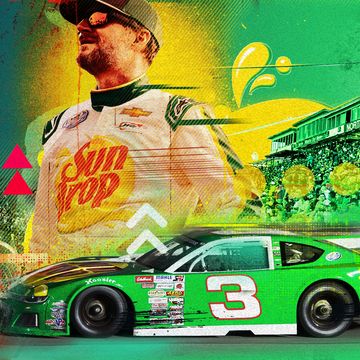In its day, the Porsche 959 was one of the most expensive cars in the world, around $225,000, depending on exchange rates. Adjusted for inflation, that's a little over $600,000. Which makes it all the more remarkable that Nissan bought one. Developing cars is an expensive endeavor, and automakers regularly purchase cars made by rivals for benchmarking. After all, you can't beat the competition if you aren't familiar with them, but in this case, Nissan wasn't building a supercar. It was building the Skyline GT-R.
Well, it tried to make a supercar beforehand. The MID4 made its debut in 1985 looking nearly production ready. It was almost something of an affordable 959, with all the latest technology. It had a version of the 300ZX's V-6 featuring an early application of variable valve timing, rear-wheel steering, and all-wheel drive. With around 200 hp in a car about the same size as the Pontiac Fiero, it was something of a junior supercar, not unlike what the NSX became, and at its targeted base price of $25,000-30,000, it would've been a big headache for the sports-car establishment. But, it never arrived. Nissan targeted an on-sale date in late 1986, though a production car never materialized. Instead, in October 1987, Nissan debuted the MID4-II concept, this time with more distinctive styling and a twin-turbo V-6, but that too never made production.
Given that 959 production began in 1987, any influence on the MID4 would've been theoretical. And while the MID4-II used a similar basic drivetrain layout as the 959 and subsequent all-wheel drive 911—engine behind gearbox, shaft going to the front axle when looking at the car from front-to-back—this all-wheel drive system was simple, with a fixed torque split of 35:65 front-rear per our drive of a prototype for the February 1988 issue.
At the same time, Nissan was working on a high-performance version of the Skyline, its home-market BMW 3-Series rival. Dennis Gorodji's book Nissan GT-R Supercar: Born to Race says that development of the GT-R was a result of the R31-generation Skyline's unpopularity. Nissan felt a version for the Group A touring car formula would help boost the Skyline's cache, and the car that resulted was the GT-R.
It's easy to see why Nissan looked to the Porsche 959 for inspiration. Basically everyone did. When the 959 arrived in 1987, it redefined the state of the art with its 450-hp race-proven twin-turbo flat-six, adjustable hydraulic suspension, and variable all-wheel drive system. It was born out of Porsche's neglect for the 911 in favor of its new, front-engine cars throughout the Seventies. When Porsche realized that its future was in the 911, it decided to create the most radical iteration yet as a way of playing catchup, and as an entrant for the much-loved Group B racing formula.
Thanks to the Audi Quattro, all-wheel drive was both a prerequisite for Group B and very much state-of-the-art for high-performance road cars. As quoted in Jürgen Lewandowski's Porsche 959 Fact Book then Porsche R&D chief Dr. Helmuth Bott said "[f]or years I had been convinced that the future would lie in four-wheel drive." Bott and the team behind the 959 wanted to push further than what Audi had established with the Quattro. "We felt that the handling characteristics had to be clearly defined—so we had to come up with an all-wheel drive that could adapt the torque distribution between the front and rear axle to cope with changing road conditions."
The original Quattro used a manually locking center differential that distributed torque evenly between the axles. As the front wheels are constantly driven, this contributes to a lot of grip, especially on loose surfaces, but also an understeer-dominant handling balance. Varying the amount of torque going to the front axle alters the handling balance. In the 959, a multi-plate clutch between the gearbox and front differential controlled how much torque went to the front axle.
In the 959, a computer interpreted engine and wheel-speed data to calculate the weight distribution at each axle. With the all-wheel drive system in its "Dry" mode, torque would shift as much as 80 percent rearwards in hard acceleration, matching the effects of weight transfer; at constant speeds, torque distribution would settle around 60-percent rear, 40-percent front, matching the static weight distribution of the car. There were also driver-selectable settings for rain and snow conditions, and a mode which locked the system at a permanent 50-50 split for getting started on a very slippery surface.
Porsche felt that sending at least 20 percent of the torque forwards at all times had positive effects on steering feel and precision and directional stability. The engineers also wanted a safe handling balance, perhaps in response to the 911's reputation as a car that primarily understeered… until it violently oversteered. The system worked very well, but it was extremely time-consuming to develop, and both heavy and costly in application. Plus, the handling balance was still primarily swung in favor of understeer.
Nissan thought it could do better. From a hardware perspective, Nissan's—deep breath—Advanced Total Traction Engineering System for All terrains and Electronic Torque Split, or ATTESA ET-S, is similar to the 959's all-wheel drive system. After the gearbox, there's a multi-plate clutch that distributes torque to the front axle via a driveshaft and an open differential. Also like the 959, the system uses engine and wheel-speed data, but it also relied on data from the ABS system and three G-sensors, two longitudinal and one lateral.
It's the operating principle where the systems differ. ATTESA ET-S sends all of the torque to the rear axle until the rear wheels start to lose grip. When the ATTESA ET-S controller sees a variance in front and rear wheel speeds, hydraulic pressure applied to the multi-plate clutch diverts torque towards the front axle. Under high lateral loads, the system reduces torque at the front, and under heavy braking, torque shifts forward to effectively increase the amount of engine braking at the front axle, thus decreasing the chance of wheel lockup.
In 1990, the UK's Car magazine tested the Skyline GT-R on the Nürburgring and described the unique handling characteristics of the car, as enabled by ATTESA ET-S and HICAS, the car's active rear-wheel steering system. In slow, tight corners, the GT-R turned in sharply, but ran into some understeer (a result of the heavy, twin-turbo straight-six mounted up front, which gave the car a 60:40 front-rear weight distribution). Still, Car's Gavin Green noted that it plowed less than a Quattro or 959, as little or no torque was sent to the front wheels in slower corners on dry pavement.
In faster corners, turn-in was also sharp—aided by the rear-wheel steer—and the car was very neutral mid-corner. On exit is where things got interesting. The driver felt the sensation of oversteer, which in a rear-wheel drive car would normally require a slight throttle lift and some countersteering, but in the GT-R, you keep your foot hard down and maintain your steering input.
"Just as the tail starts to move, it is denied some of the power—which instead is fed to the front. The rear tire slip angle is thus reduced, and the front increased. And by keeping the car on full throttle—and thus losing no time—the car magically straightens its line, and exits the corner tidily and neatly, with no tail-out nonsense. No need to correct the steering, or to back off. No need to do anything except steer the car normally. The car does the correcting for you."
No all-wheel drive system before ATTESA ET-S worked like this. Not even the 959's. It made its production debut in 1989 on both the Skyline GTS-4 and the GT-R. In racing, it was devastatingly effective. Group A GT-Rs were generally heavier than their rivals, but more than compensated with more power—generally well over 600 hp—and an all-wheel drive system that could deal with all that grunt. Sights of the GT-R four-wheel power oversteering on corner exit became common in touring-car racing around the globe. GT-Rs won every single All-Japan Touring Car Championship race from 1990 to 1993, the 1991 Spa 24 Hours, three Group A championships plus the 1991 and 1992 Bathurst 1000 in Australia. It was those victories in Australia that earned the GT-R its famous moniker—Godzilla.
The road car used ATTESA ET-S to similar effect. A Nissan test driver famously lapped the GT-R around Nürburgring Nordschleife in 8:22, faster than any other production car of the time. Nissan implemented ATTESA ET-S throughout its lineup, and the automaker made a notable improvement to the system in 1995 in the form of an active limited-slip differential to control power across the rear axle. This updated system, called ATTESA ET-S Pro, was available as an option for the R33-generation Skyline GT-R.
Other automakers were clearly looking at Nissan. Mercedes's first iteration of its 4Matic all-wheel drive system actually predates ATTESA ET-S, introduced for the W124-chassis E-Class in 1987. 4Matic too only engaged the front wheels some of the time, however, there wasn't much variability in the system, with a center differential locking to create a 35:65 front-rear torque split when it detected traction loss as the rear axle. The system also deactivated with ABS ABS. It wasn't reliable, either, so Mercedes dropped 4Matic in the early Nineties, and the nameplate wasn't reintroduced until later in the decade.
Porsche introduced all-wheel drive to the 911 with the 964 Carrera 4 of 1989, but it used a far simpler system that operated primarily with a torque split of 31:69 front-rear. That gave the Carrera 4 a very understeer-heavy handling balance. This improved dramatically with the 993 Carrera 4, which used a viscous coupling to send more torque forwards when there was a big difference between front and rear wheel speeds. Typically, the system sent about 5 percent of the torque forwards, but could send as much as 40 percent. It wasn't until the 2006 911 Turbo that Porsche started using a multi-plate clutch like the R32 GT-R, and in 2013, it switched to electro-hydraulic clutch actuation, completing the circle.
Throughout the Nineties and into the Aughts, other automakers started embracing all-wheel drive, each developing slightly different systems tailored to their unique models. No one copied ATTESA ET-S exactly, but many use a similar philosophy. In performance cars, rear-wheel drive was (and is) common, but during the mid/late-2010s, both BMW M and Mercedes-AMG developed systems remarkably similar to ATTESA ET-S. Both M xDrive and 4Matic+ send all their torque to the rear axle in normal driving and use a multi-plate clutch to apportion torque to the front axle. The systems never send that much power to the front wheels, just as in the Skyline GT-R, though new electronic controls allow both to offer genuine rear-wheel drive modes, where the front axle is totally disengaged. Like the Skyline GT-R, these systems mix the best of rear- and all-wheel drive.
ATTESA ET-S continues on in the current R35 GT-R, where it's been adapted to work with the car's novel front-engine rear-transaxle layout and uses much more sophisticated computer controls to determine torque split. Still, the basic operating principle is the same—rear-wheel drive until you need more traction.
Hybrid and electric cars are changing the all-wheel drive equation, as a simple electric motor driving an axle can provide all-wheel drive on its own. However, the fundamentals that make up a good-handling car haven't changed, and so in the age of torque deployment rather than torque distribution, the thinking that defined ATTESA ET-S is still relevant.
All it took was the purchase of a Porsche 959.
A car enthusiast since childhood, Chris Perkins is Road & Track's engineering nerd and Porsche apologist. He joined the staff in 2016 and no one has figured out a way to fire him since. He street-parks a Porsche Boxster in Brooklyn, New York, much to the horror of everyone who sees the car, not least the author himself. He also insists he's not a convertible person, despite owning three.




























